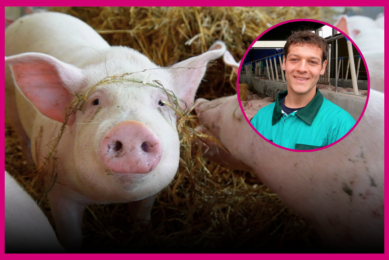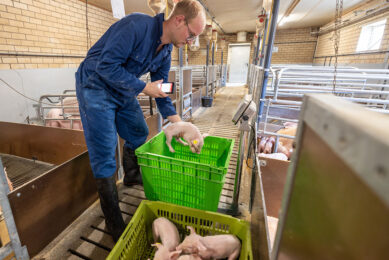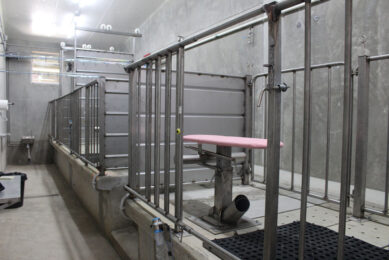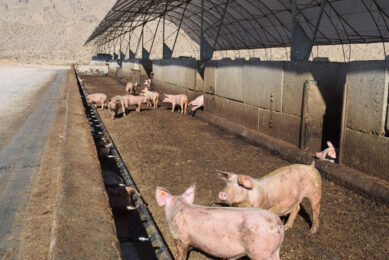New meets old at the shores of the Black Sea
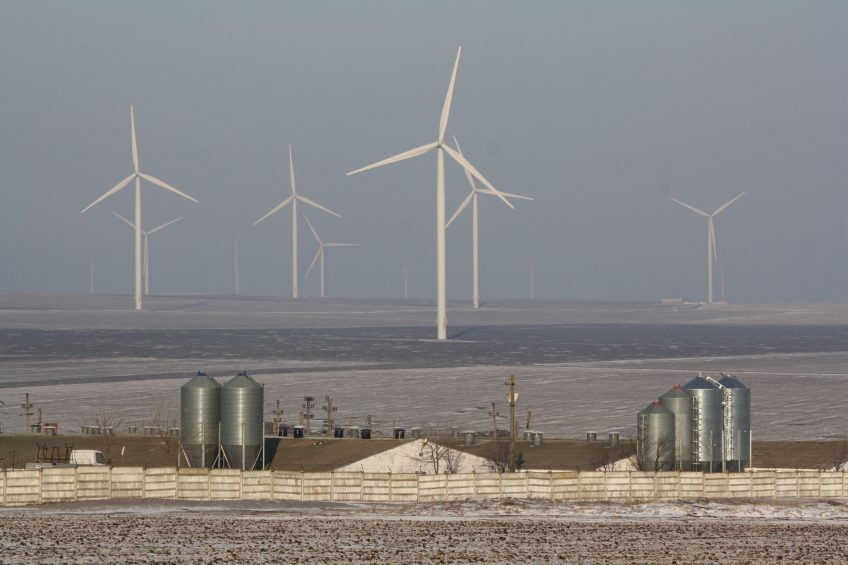
In one of the easternmost places of the European Union, pig farming is a mix of both opportunities and challenges – as well as an interesting combination of modern farming practices in a traditional countryside. Degaro Farm, not far from Constanta, Romania, came in Danish hands in 2011, and has since stepped up its productivity to 32 piglets/sow/year.
There doesn’t seem to be a lot of activity in the countryside north of Constanţa. Mostly, it’s plains – endless fields for crop culture in summer. In this winter time, however, the treeless landscape, covered under a little layer of snow, seems utterly desolate. Sporadically, the route leads through a small village, in which time stood still. Elderly people and stray dogs roam the streets, its post office is in need of some repair and regularly, donkey drawn carts make their way on the roads.
“The sow complex of Degaro Farm is in the middle of a forest of modern windmills,” observes Lars Drescher, unexpectedly, from the front of the car. “I hear they eventually want to build about 1,000 of them over here. But even now it looks quite sophisticated.”

Drescher, 39, is CEO for DCH International, a Danish conglomerate of pork producers who invested part of their money in pork production abroad. Spurred by skyrocketing land prices in Denmark, many Danish pork producers decided to take their knowledge abroad, about ten years ago. They invested in new complexes abroad, some even ‘with eyes wide shut’, admits Drescher, a farm manager earlier in his career.
DCH started out investing in a project in Canada before setting its eyes on Romania. In 2006, two farrow-to-finish sites near the town of Focşani were bought, about 175 km north of Bucharest – and a greenfield feed mill was built in 2008. In 2011 the company found a third investment site – this two-complex farm, about 50 km north of Constanţa, literally at the shores of the Black Sea.

Landscape
Shortly before the car approaches the village of Fântânele, the landscape changes – it is covered with large white statute-like windmills in every direction possible. Somewhere in between two rows of them, the breeding farm is located – surrounded by a wall and barbed wire on top.
“As much as we hate it, we need round-the-clock guards and fences around the complexes,” explains Drescher. “Unfortunately some Romanians do steal – and we need to keep a close eye on them. It’s part of their culture, due to communism.”
It goes to show that producing in Romania is just not a matter of low employee costs, he stresses. “Apart from guards, we need to have more workers employed. On top of that, we need extra administrative staff to cope with bureaucracy.” Reasons of escaping the strict Danish environment regulations do not apply either, Drescher states. “Everything we do here is in line with EU and Danish standards.”
So what is it, that the DCH group made move the step to Romania? “Market opportunities,” Drescher says without a moment of hesitance. “We believe in the chances over here.”
Opportunities
In 1978, the Communist Party decided to have the two-site complex built. About ten years it was in operation – until a Trichinella infection and a subsequent farm depopulation put an end to the business. Difficult years followed. The complex’s slaughterhouse remained in full swing – the rest of the eight buildings were occupied by a producer having only about 100 sows, hardly a fruitful amount for a complex of this size.
By 2003, Spanish pork processor Campofrio bought the complex. Using Spanish housing and equipment material to renovate the farm complex, Campofrio stayed about six years. When a contaminated shipment from Western Europe, however, brought in a Brucellosis infection in 2008, Campofrio had to depopulate too, leaving the facilities up for whomever was interested.
It was in 2011, that Drescher went to Spain to discuss the acquisition of Degaro farm.

Breeding site
The breeding site, near Fântânele, consists of thirteen pig houses, all built in pre-fabricated, standard-size communist dimensions of 120 m x 18 m. At the moment, eight of them are taken into use – offering a place for a total of 3,000 sows, about 8,000 weaner pigs and about 50 Duroc boars.
Like can be expected on a project run by Danish, biosecurity and a high health status take an important place in farm management. A fresh Danbred breeding herd with Specific Pathogen Free status was introduced on the farm in July 2011, after which the breeding farm was and has stayed closed.
Maintaining the high health status means mandatory showers for anybody wishing to enter or leave any of the pig houses. In addition, on-farm biosecurity was enhanced by the construction of ‘pig corridors’ between the gestation, lactation and weaner facilities. This allowed a structured flow of pigs from one house to the other, and the permanent closing of other doors that had been opened in the past to facilitate the pig movement.

Apart from these biosecurity additions, many of the farm’s buildings were in dear need of renovation. In the past, DCH had tried to perform necessary construction works itself – in this project, Danish agricultural construction company Graakjaer was invoked.
Steen Pedersen, DCH Agro Invest Moldova, explains that this took a lot of time and effort. Throughout the whole farm, the manure system had to be changed. Too narrow pipes caused only the liquid fraction to be well pumped off to the lagoon – and the solid manure often to be left behind under the pig houses, causing a lot of extra work. Apart from that, in virtually all houses, the feeding systems were replaced by Skiold automatic feeding lines.
Where house 1 (H1) is used for the boars and insemination, H2 and H3 are the location for group-housed sows, fed using floor feeding. Pedersen says, “We had to replace the floors in these houses as the old ones were unstable and hard to clean. We constructed layers of concrete of 5-10 cm.”
H4 and H5 are the farrowing sections – it was here most work needed to be done, Pedersen explains. “Feeding used to be done by hand here. We wanted to introduce automatic feeding, so we had to turn the pens around. All the equipment and all slats had to be taken out, then the same equipment, together with new feeding systems had to be put back in again. In total we replaced the slats in two to three sections with Ikadan material, as the quality was bad.” In addition, the existing electrical floor heating system in the farrowing rooms was also taken out and replaced by more efficient central heating, on gas and lamp-lit covers for the piglets in the farrowing areas.
In H6 and H7, used for 4,000 grower pigs (7-30 kg) each, the emphasis was on creating double capacity for the feeding system. Not two lines, but four lines had to be installed, to be able to offer four different types of feeds to diversify between age groups. In order to have this installed, all equipment needed to be taken out and put back again at a later stage.
In H8, destined for gilts, the flooring and the feeding system were replaced.
Last but not least, the Danish added two new buildings to the complex: A crematorium for dead pigs, as well as a new slurry tank. Again, biosecurity is the main driver, as both help to maintain the farm’s health status.

Finisher site
The finisher farm is located in the village of Piatra, about 25 km south of the breeder farm. The seven-building complex, for about 16,000 finishers, is located on a slope, with the long pig buildings placed parallel on the slope’s side one above the other. A central, mounting corridor connects them.
Of course, just as in the breeding facility, showering has been made mandatory. Often, a good cleanout of the buildings was sufficient, Drescher explains. The only elements replaced there were the drinking and feeding systems.
The purchase of the Black Sea complex also included a feed mill, adjacent to the finisher farm. This complex is now used as a storage facility. Most feed is produced in the feed mill in Focşani.

Future
Total investments for Degaro Farm amounted to €4.8 million, €2.3 million for the purchase and another €2.5 million for the renovation.
Although this farm is now profitable, the pig industry in Romania as a whole is not exactly growing at the moment. Commercially produced finisher pigs have amounted to 2 million head and about the same is being produced in backyard production. The balance does not shift stronlgy towards more industrially produced pigs. It’s the financial crisis, Drescher explains, while the car is making its way back to Bucharest. “As soon as people will have more money, things will change.”
Smithfield shall be the main company to benefit, having 850,000 pigs produced per year in Romania. Although substantially smaller in size, DCH comes third, together with some other breeding companies, with altogether about 7,500 sows and 3,000 ha land and with more acquisitions planned for the future. So once the Romanian pig industry will really start to thrive, a front row seat is booked for DCH.
Now there’s a good thought – and Drescher smiles. “I really hope so.”
Apart from the people mentioned in this article, this feature has been made possible through the kind cooperation of Kasper Dahl Andersen (Degaro Farm) and Michael Mikkelsen (Graakjaer).



